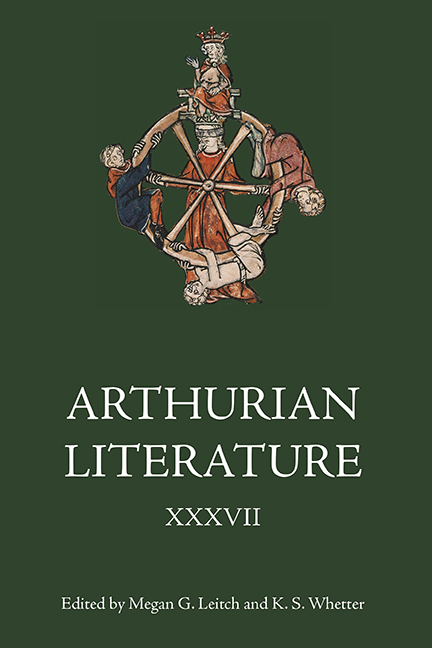Book contents
- Frontmatter
- Contents
- List of Charts and Tables
- Professor Fiona Tolhurst (1968–2021)
- General Editors’ Preface
- List of Contributors
- List of Abbreviations
- Introduction: The Tournament at Mapplemalleoré: Malory at 550
- 1 Malory and the Stock Phrase
- 2 The Artistry of Malory’s Mercantile Metaphors: Goods, Generosity, and the Source of ‘The Tale of Sir Gareth’
- 3 ‘A grete bourder and a passynge good knyght’: Sir Dinadan: ‘Gareth with a Twist’
- 4 Moonlight in the Nocturnal Typology of Malory’s Morte Darthur
- 5 ‘That shall nat ye know for me as at thys tyme’: Cognitive Narratology and Filling Malory’s Gaps
- 6 ‘On a tyme’: Action and Temporality in Malory’s ‘Sankgreal’
- 7 Hospitality in Malory
- 8 The Haunting of the Orkneys and Malory’s Arthurian Project
- 9 ‘I love nat to be constreyned to love’: Launcelot and Coerced Sex
- 10 Eradicating Victorian Backreading: Re-reading Malory’s Gwenyvere through Gaynour and Isode
- contents of previous volumes
10 - Eradicating Victorian Backreading: Re-reading Malory’s Gwenyvere through Gaynour and Isode
Published online by Cambridge University Press: 15 September 2022
- Frontmatter
- Contents
- List of Charts and Tables
- Professor Fiona Tolhurst (1968–2021)
- General Editors’ Preface
- List of Contributors
- List of Abbreviations
- Introduction: The Tournament at Mapplemalleoré: Malory at 550
- 1 Malory and the Stock Phrase
- 2 The Artistry of Malory’s Mercantile Metaphors: Goods, Generosity, and the Source of ‘The Tale of Sir Gareth’
- 3 ‘A grete bourder and a passynge good knyght’: Sir Dinadan: ‘Gareth with a Twist’
- 4 Moonlight in the Nocturnal Typology of Malory’s Morte Darthur
- 5 ‘That shall nat ye know for me as at thys tyme’: Cognitive Narratology and Filling Malory’s Gaps
- 6 ‘On a tyme’: Action and Temporality in Malory’s ‘Sankgreal’
- 7 Hospitality in Malory
- 8 The Haunting of the Orkneys and Malory’s Arthurian Project
- 9 ‘I love nat to be constreyned to love’: Launcelot and Coerced Sex
- 10 Eradicating Victorian Backreading: Re-reading Malory’s Gwenyvere through Gaynour and Isode
- contents of previous volumes
Summary
Gwenyvere has received much more attention from literary critics than have other female characters in Sir Thomas Malory's Morte Darthur. Nevertheless, she has often been misread. Critics’ consistent misreading of Arthur's queen is the result of three interrelated causes: a Victorian sensibility that leads critics to denigrate and trivialize Gwenyvere yet attempt to deny the sexual nature of the Gwenyvere–Launcelot relationship; a consistent underestimation of the stanzaic Morte Arthur's influence on both Malory's development of characters and his conception of the Arthurian world; and an insistence that Malory's Trystram section depicts the failings – rather than celebrates the glories – of Arthurian knighthood through the Isode–Trystram relationship. Because critics have so consistently underestimated how much Gwenyvere resembles her literary foremother Gaynour, they have undervalued Gwenyvere's gender-bending combination of positive traits: wifely loyalty to Arthur, knightly willingness to hazard her body, and kingly protection of both the knights who serve her and the Tower of London. Furthermore, because critics have so consistently disparaged the love of Isode and Trystram, Gwenyvere has suffered the same denigration as her literary sister Isode. However, if critics set aside the interpretive practice of what I term Victorian backreading, the queen's ongoing denigration, trivialization, and desexualization become untenable. In addition, if critics fully acknowledge Malory's reliance upon the stanzaic Morte, Gwenyvere's strength as a character modelled upon her stanzaic counterpart Gaynour becomes evident. Finally, if critics set aside their assumption that the Trystram section depicts the erosion of chivalric values and thus prepares for the political disaster that Gwenyvere's affair with Launcelot supposedly causes, they can recognize both Isode and Gwenyvere as positive female figures. Re-reading Malory's Gwenyvere enables Isode to emerge as both a model courtly lady and a common-law wife to the noble Trystram, for the treacherous King Mark does not deserve her loyalty. It also enables Gwenyvere herself to emerge as a loyal, politically savvy, knightly, and at times kingly queen who inspires both the loyalty of the knights who serve her and the sympathy of readers. By eradicating Victorian backreading from their current scholarly practice, literary critics can recognize Malory's Gwenyvere for what she truly is: Gaynour's wise and brave literary daughter and Isode's loyal and noble literary sister.
- Type
- Chapter
- Information
- Arthurian Literature XXXVIIMalory at 550: Old and New, pp. 193 - 230Publisher: Boydell & BrewerPrint publication year: 2022



